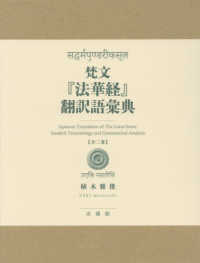- ホーム
- > 洋書
- > 英文書
- > Science / Mathematics
Full Description
This up-to-date reference discusses important concepts of vehicular communication in intelligent transportation systems. Augmented Intelligence Toward Smart Vehicular Applications begins by discussing key objectives of intelligent transport systems and vehicular ad-hoc networks (VANETs). It then goes on to discuss challenges, applications and future trends in VANETs. The text focuses on the organization of artificial intelligence (AI) and aspects of deep learning algorithms, particularly multimodal transport. This book will serve as an ideal reference for graduate students and academic researchers in the field of electrical engineering, electronics and communication engineering and transportation engineering.
Features
In-depth coverage of Internet of Things (IoT) in vehicular applications
Discussion on nn-vehicle sensor networks
Implementation of mobile IP and migration of IPv6
Focus on the need of AI in smart vehicular applications
Discussions on advanced concepts in the field of intelligent transport systems
Contents
PART I - INTRODUCTION
CHAPTER 1: Augmented Intelligence and Edge Computing: Introduction and Trending Features
CHAPTER 2: Edge Computing and Embedded Storage
CHAPTER 3: Application of VANET to Avoid the Pedestrian Collision in Automotive Vehicles
PART II - DESIGNING AND EVALUATION
CHAPTER 4: Design of Platoon Controller with V2V Communication for Highways
CHAPTER 5: Using Computer Simulations for Quantifying Impact of Infrastructure changes for Autonomous Vehicles
CHAPTER 6: A Comprehensive Simulation Environment for Testing the Applications of a V2X Infrastructure
CHAPTER 7: A Novel Approach in Communication Security of Internet of Vehicle using the concept of Recurrence Relation and Symmetric Key
PART III - SMART SAFETY MEASURES AND APPLICATIONS
CHAPTER 8: Hybrid Data Structures for fast queuing operations in Vehicular Communication
CHAPTER 9: An IOT Based Accident Detection and Rescue System- A Prototype
CHAPTER 10: Intelligent Mobility for Minimizing the Traffic Incidents' Impact on Transportation Network








